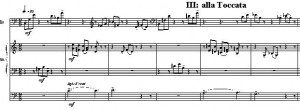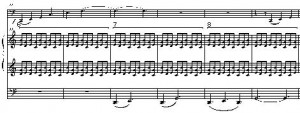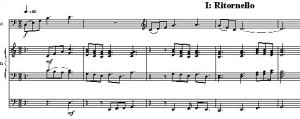Fantasy Variations: a composition for cello and organ
Duration: 12’10”
Description: This work, a rather free (hence the “fantasy” in the title) variations on the hymn tune Bunessan, associated most often with the hymn Morning Has Broken, was written for my cousin Michael Moreskine. He premiered the work in the fall of 2004 (giving a rather nice performance, I must say). The six variations–or, rather, theme and five variations– explore different treatments of the tune. In some, the tune is there, but you can’t hear it. In others, melodies are built up out of the notes of the tune, but with different rhythms. A couple use the tune as the starting point, but head in their own directions. Canons abound.
While movements could well be excerpted for church service use (prelude, or interlude, or offertory), I intended the work for concert use. It shows off the virtuosity of both musicians, and in aggregate has to fit into the “Advanced” or “Hard” category of difficulty. It’s a satisfying piece for the performers; audience response was also quite favorable.
1. Ritornello: The theme is introduced (notice that it moves from cello to organ and back). Elements of the Ritornello…return…later in the variation set. [fv1]
 2. First Commentary. Michael came up with the name “Commentary.” It’s not a classical variation, but the tune certainly informs the movement in subtle ways. The second half of the movement is a cello recitative over extended organ chords. The cellist really got into it. [mp3]
2. First Commentary. Michael came up with the name “Commentary.” It’s not a classical variation, but the tune certainly informs the movement in subtle ways. The second half of the movement is a cello recitative over extended organ chords. The cellist really got into it. [mp3]
 3. alla Toccata: It’s a relatively fast-moving toccata. The tune operates on a couple of levels: it slowly unfolds (the first c in the cello; the e in the organ; the g in the cello; the c and d in the organ pedal–this unfolding lasts through the entire movement); the triads of the first measure are derived from the first three notes of the tune (other material comes from other parts of the tune). Enjoy! [fv3]
3. alla Toccata: It’s a relatively fast-moving toccata. The tune operates on a couple of levels: it slowly unfolds (the first c in the cello; the e in the organ; the g in the cello; the c and d in the organ pedal–this unfolding lasts through the entire movement); the triads of the first measure are derived from the first three notes of the tune (other material comes from other parts of the tune). Enjoy! [fv3]
 4. with sweet singing. The ritornello is scattered throughout this movement, which makes use of moment form…which means that several motives, or moments, are created from the tune ( moment A is based on the first phrase, while B is based on the second) and then transposed or varied in some fashion each time the recur. Essentially all of the A measures make up a variation, while B, C and D moments have their own variations. The effect should seem random, yet with a sense of organization that you just can’t quite explain… [fv4]
4. with sweet singing. The ritornello is scattered throughout this movement, which makes use of moment form…which means that several motives, or moments, are created from the tune ( moment A is based on the first phrase, while B is based on the second) and then transposed or varied in some fashion each time the recur. Essentially all of the A measures make up a variation, while B, C and D moments have their own variations. The effect should seem random, yet with a sense of organization that you just can’t quite explain… [fv4]
 5. Second Commentary: There’s a canon–or is it a slow-motion race?–between the manuals and the pedal, against which the cello provides what seems to be an unrelated, though rather lyrical, melody. It actually does relate: both instruments gradually work their way through the tune, focusing on a set of adjacent notes, then letting go of a couple and adding on the next couple–I’ll leave the actual solution for the performers! [fv5]
5. Second Commentary: There’s a canon–or is it a slow-motion race?–between the manuals and the pedal, against which the cello provides what seems to be an unrelated, though rather lyrical, melody. It actually does relate: both instruments gradually work their way through the tune, focusing on a set of adjacent notes, then letting go of a couple and adding on the next couple–I’ll leave the actual solution for the performers! [fv5]
 6. Finale. This movement is just simply difficult. The organ part takes some practice, less for learning notes, since the part is actually quite minimal, than for gaining endurance and strength (this movement is about 5 minutes long). The cello freely explores the tune. The duples and triples present a challenge to the cellist, as does the matter of just simple keeping one’s place in the movement. The organ at best is a bit sloppy at rhythmic precision (at least compared with most orchestral instruments); the minimalist repetition of chords adds to the confusion. As composer, I’m less concerned about everything being exact (there are several signposts along the way where the musicians can get back into synch) than I am with the gesture: strong, vigorous cello playing versus the slowly evolving yet quickly moving wash of sound from the organ. [mp3]
6. Finale. This movement is just simply difficult. The organ part takes some practice, less for learning notes, since the part is actually quite minimal, than for gaining endurance and strength (this movement is about 5 minutes long). The cello freely explores the tune. The duples and triples present a challenge to the cellist, as does the matter of just simple keeping one’s place in the movement. The organ at best is a bit sloppy at rhythmic precision (at least compared with most orchestral instruments); the minimalist repetition of chords adds to the confusion. As composer, I’m less concerned about everything being exact (there are several signposts along the way where the musicians can get back into synch) than I am with the gesture: strong, vigorous cello playing versus the slowly evolving yet quickly moving wash of sound from the organ. [mp3]
